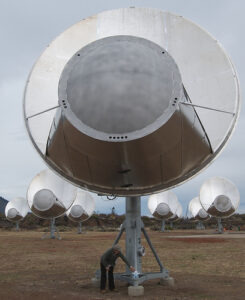Jul
31
Sending E.T. an S.O.S.
“We’re kind of the chimpanzee ‘fighting’ civilization. Some other civilization just may have a basically more peaceful personality, like bonobos do.” — Stuart Taylor, SETI astrophysicist
The technology to send it isn’t in place yet, but JPL astrophysicist Jonathan Jiang and other researchers have already drafted a new message to broadcast to any alien intelligences that may be listening. And they want feedback. As per LiveScience, they “hope to spark a conversation about what information to send to extraterrestrials and to revive interest in listening for messages.” So, I guess they are open to suggestions for additions and other modifications to what they have come up with.

Several earlier, simpler messages — both physical items and via radio — have gone out over the decades to different parts of the sky. Perhaps the best known were sent from Pioneer spacecraft (1972, 1973), the now-defunct-and-demolished Arecibo radio telescope in Puerto Rico (1974), and the Voyager spacecraft (1977). Candidates for modification to send this message are China’s Five-hundred-meter Aperture Spherical radio Telescope (aka FAST, or the Tianyan telescope) and the Allen Telescope Array (ATA) in northern California. The latter was actually designed to search for extraterrestrial signals, and SETI uses it every day.
Like its predecessors, the new message will take many thousands of years (at the speed of light) to reach its destination. That destination will be “a ring of stars about 13,000 light-years from the center of the Milky Way,” in a promising region with planets located within the habitable zones of their respective stars. (I hope they remember that deadly radiation increases the closer one gets to the center of a galaxy, a detail that many forget in their optimism.)
It will include a line drawing of a man and a woman similar to those on the Pioneer plaques, but with the woman also waving. According to LiveScience‘s Stephanie Pappas,
“[The Arecibo] message used binary code and conveyed information about humanity’s base-10 counting system, common important elements and a map of the solar system. The new message, described in a paper published to the preprint database arXiv, also encodes information in binary and describes basic math, physics and biology that aliens would need in order to understand humans, including descriptions of DNA, amino acids and glucose. It would also contain a map of the Milky Way, the solar system and Earth itself, including information about the makeup of the planet and its atmosphere.”
In other words, we are going to send enough information about where we are, what we breathe, and what we’re made of so that any alien race that wants to eat, enslave, or just wipe us out can do so much more easily and efficiently. Isn’t that nice of us?!
Personally, I’m not all that worried about that possibility, because I tend to think the Earth and its advanced life are unique in the universe. (Multiverse?) Plus, there’s the whole thousands-of-years-away factor, among others that mitigate against interstellar space travel for us or them. (Perhaps a subject for a future post.)

On the other hand, on the chance that extraterrestrial intelligences do exist and might detect and properly interpret our message, do we really want to risk the existence of the entire human race on the “hope… that an alien civilization advanced enough to reach for the stars would be highly cooperative — the ‘bonobos of the galaxy’ — and have good advice for Earthlings on how to reconcile our differences”? (H/T Pappas quoting/paraphrasing Taylor)
Why do people assume that advanced technology indicates such a civilization would be “good guys”? Intelligence does not guarantee wisdom or kindness. Human history has shown that, along with positive applications, scientific and technological advances make it easier to kill or subjugate one’s enemies. As for cooperation, there are plenty of social species on Earth (e.g., some wasps, wolves), but they are hostile or predatory toward others. Why assume that an extraterrestrial race would be any different? Why risk that the ones who respond to our message will be “bonobos”, when they could just as well be “chimpanzees” or worse?
Lest I end this on a negative note, Pappas says the new message-to-the-stars will be “more advanced” in “several key ways”, thanks to — you guessed it — scientific and technological advances. For example, “its map of Earth’s location in the Milky Way is more precise than the one in the Arecibo message,” using “globular star clusters in the Milky Way as landmarks” this time instead of the locations of pulsars (which change over time).
Another example is “a first-of-its-kind time stamp so that any alien intercepting the message would know when it was sent.” It uses the “spin-flip transition” of a hydrogen atom between higher- and lower-energy states roughly every 10 million years. With this time unit established, we can tell the aliens how long after the Big Bang the message was sent.
Sounds pretty cool!















